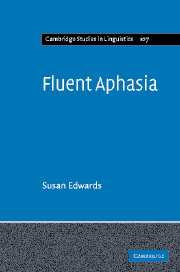Book contents
- Frontmatter
- Contents
- List of figures
- List of tables
- Acknowledgements
- Introduction
- 1 Fluent aphasia: identification and classic descriptions
- 2 Descriptions of fluent aphasia
- 3 Assessment and fluent aphasia
- 4 Connected fluent aphasic speech
- 5 Non-fluent and fluent aphasic speakers. What are the differences?
- 6 Comprehension and processing problems in fluent aphasia
- 7 The manifestation of fluent aphasia in one speaker
- 8 Some concluding thoughts
- References
- Index
2 - Descriptions of fluent aphasia
Published online by Cambridge University Press: 22 September 2009
- Frontmatter
- Contents
- List of figures
- List of tables
- Acknowledgements
- Introduction
- 1 Fluent aphasia: identification and classic descriptions
- 2 Descriptions of fluent aphasia
- 3 Assessment and fluent aphasia
- 4 Connected fluent aphasic speech
- 5 Non-fluent and fluent aphasic speakers. What are the differences?
- 6 Comprehension and processing problems in fluent aphasia
- 7 The manifestation of fluent aphasia in one speaker
- 8 Some concluding thoughts
- References
- Index
Summary
I am always TV … sometimes … I don't care … I can't do it … it doesn't matter if I can't do it just because I do it but that's all I can because I can't reading.
Introduction
The above quote was the answer given by a fluent aphasic speaker when asked what he did in the evenings. In this chapter we will explore accounts of the speech of fluent aphasia, looking at the characteristics of the language disorder. In particular, we will look at accounts that have attempted to quantify features of the condition and at accounts resulting from a comparison of fluent aphasia and non-fluent aphasia. Some of these accounts result from group studies, although group size is usually small, while others use single cases, following in the tradition of the early aphasiologists such as Wernicke. Some researchers attempt to offer explanations of the phenomena either in terms of psycholinguistic processing or, more unusually, in terms of some linguistic theory of how language is organised. The chapter starts with a brief overview of one model of sentence processing current in cognitive psychology. We then turn to levels of linguistic description, a familiar approach in clinical aphasia in the UK, for our account of production deficits. Comprehension deficits are considered in chapter 6.
A sentence-processing model
Models of language processing are increasingly referred to in the clinical aphasia literature and favoured by cognitive psychologists working in the field.
- Type
- Chapter
- Information
- Fluent Aphasia , pp. 32 - 61Publisher: Cambridge University PressPrint publication year: 2005



